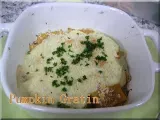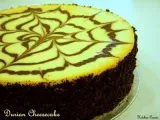Duck Foie Gras cooked sous vide at 58°C during 47 minutes


In France, during Christmas time, eating foie gras is very popular. Remember that the sous vide method was developed by Georges Pralus in the 70s in order to cook foie gras in an optimal way.
For the first time I tried to cook myself a duck foie gras sous vide.
First issue is to choose a good raw foie gras of quality…The South Ouest of France is the region where the foie gras is originally produced. If you choose one of those, there is a small risk to make mistakes.

Then, you must take off the veins of the foie gras (sometimes you can purchase the foie gras without the veins). This is where the problem started…This is not an easy part of work. I looked on internet some videos illustrated the key points and technique to take off veins of a foie gras and then I tried myself. The difficult thing is to find the veins, take them off without destroying the whole structure of the foie gras.

It was very hard to do. On the right you can see the pieces of foie gras containing the veins and on the left the foie gras I almost totally destroyed!

Then I added 13g salt per kilo and 3g of pepper per kilo of foie gras. Some people recommend seasoning the foie gras with Armagnac or Porto. I put no alcohol at all.
Next step is to create a “ballotine”.

The “ballotine” was also not easy to form. I took a food grade plastic wrap, put the foie gras pieces inside and compressed them, first to take off the air but also to create a cylinder. Several plastics wrap pieces were necessary to fulfill this step.
Next step was to vacuum the foie gras in a pouch. I read on internet that the best way to keep a frame while cooking was to use a “shrink” bag. I didn’t have any so I did it with a regular cuisson sous vide bag.
Cooking the foie gras ballotine: my foie gras cylinder was approx. 17 cm long and 6 cm of diameter. The more an ingredient is fat the best it conducts heat. I cooked my ballotine at 58°C during 47 minutes with immersion circulator.
During the cooking process air appeared in the ballotine and my pouche started to float on the surface. I have probably not compressed enough the foie gras and not vacuumed enough the pouch. Therefore I fixed the pouch with a heavy tool down in my cooking pot.

Next step was to chill the ballotine. As you can see I took this task very seriously.

My foie gras became slightly brown and a significant amount of yellow fat appeared on one side of the pouch (unfortunately you can’t see it on the picture). I was surprised to see that by ballotine kept its cylinder frame. My worry was to maintain this frame until the total cool down of the foie gras. For this purpose I took a piece of carton I curved like a half-cylinder and place the ballotine inside. After I left the ballotine in the fridge for a night with the carton, the whole ballotine kept its perfect frame of a cylinder.

The result was really not so bad! With a little bit of fig, the taste was marvelous and the texture fantastic.

In addition, a little bit of Sauterne Château de Rolland (Barsac) 2004…Très, très bon!
Jean-François

















Comments
You can also print the weekly menu here.





